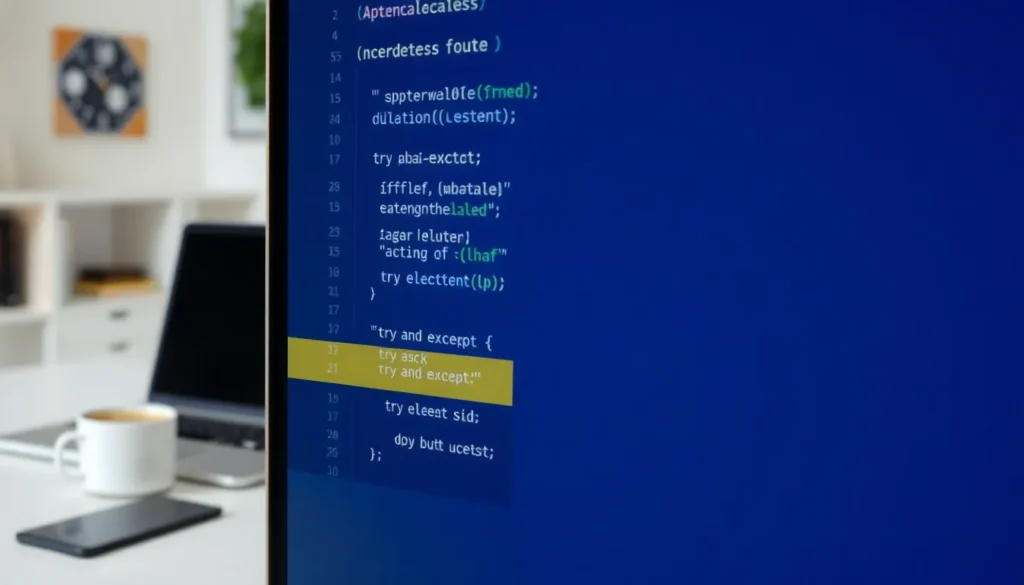
“
In the quirky world of Python programming, error handling can feel like trying to herd cats. Enter the dynamic duo: try and except. These handy constructs swoop in to save the day when things go awry. Instead of letting your code crash and burn like a poorly made soufflé, they help manage those pesky exceptions that pop up unexpectedly.
What Are Try And Except In Python 2579xao6
Try and except statements in Python handle errors during program execution. They provide a structured approach to catching and managing exceptions. When a block of code in the try statement raises an error, the except blocks come into play.
Using try, developers can wrap code susceptible to failure. An example involves file operations, where a file might not exist. The following code snippet showcases this:
try:
with open('file.txt', 'r') as file:
data = file.read()
except FileNotFoundError:
print(""The file was not found."")
In this instance, the program attempts to open and read a file. If the file doesn’t exist, it raises a FileNotFoundError, allowing the program to handle the exception gracefully instead of crashing.
Multiple except clauses can target different error types. This allows more refined error handling. For example:
try:
result = 10 / 0
except ZeroDivisionError:
print(""You can't divide by zero."")
except Exception as e:
print(f""An error occurred: {e}"")
Here, the code first catches a ZeroDivisionError. If another error occurs, the generic exception captures it, maintaining control flow.
Besides these, the finally clause can follow try and except blocks. This clause executes regardless of whether an error occurred. It’s useful for cleanup actions, such as closing files or releasing resources.
Robust error management enhances code reliability. Using try and except constructs, Python developers promote better user experiences through predictable and controlled error handling.
The Purpose of Try and Except
Try and except blocks serve a crucial role in error handling within Python. They manage exceptions, which leads to a more stable and user-friendly experience.
Error Handling
Errors occur during program execution, and try and except constructs effectively trap these issues. A try block contains code that might generate an exception. When an error arises, the associated except block activates, allowing the programmer to specify a response. For example, a developer might catch a ValueError to provide informative feedback to users. This systematic approach reduces crashes and enhances overall code reliability.
Graceful Program Termination
Graceful termination of a program hinges on effective error management. By utilizing try and except, developers ensure that users receive clear information rather than cryptic error messages. Implementing a finally block within this structure guarantees execution of essential cleanup code. Files can be closed or resources released, even if unexpected errors arise. Such practices promote operational integrity and foster user trust by making applications more resilient.
How to Use Try and Except
Using try and except in Python allows for effective management of errors. Both constructs create a robust way to catch and handle exceptions, which improves code stability and user experience.
Basic Syntax
The basic syntax for using try and except is straightforward. Begin with the try keyword, followed by a code block. If an exception occurs within this block, control shifts to the corresponding except block. Multiple except clauses can also address different types of exceptions. For example:
try:
# Code that may cause an exception
except ExceptionType:
# Code that runs if the specified exception occurs
This structure minimizes potential application crashes by providing clear paths for error handling.
Example of Try and Except
An example illustrates how try and except function in practice. Imagine a scenario where a program attempts to read a file. The following code snippet demonstrates this:
try:
with open('file.txt', 'r') as file:
data = file.read()
except FileNotFoundError:
print(""The specified file does not exist."")
In this case, if file.txt does not exist, the program catches the FileNotFoundError, avoiding a crash and displaying a user-friendly message instead. This approach enhances the application’s reliability and maintains user trust.
Common Exceptions in Python
Python provides a variety of built-in exceptions that developers can encounter frequently. These exceptions, such as TypeError, ValueError, IndexError, and KeyError, signify specific problems that arise during execution. A TypeError occurs when an operation or function is applied to an object of inappropriate type. ValueErrors arise when a function receives an argument of the right type but an inappropriate value. IndexErrors are encountered when attempting to access an index that does not exist in a list or tuple, whereas KeyErrors happen when trying to access a dictionary with a key that is not present.
Creating custom exceptions allows developers to define specific error types tailored to their applications. By subclassing the Exception class, programmers can produce exceptions that convey clear, contextual messages pertinent to their unique scenarios. It’s essential to include helpful information in these custom exceptions, so users understand what went wrong. For example, if a function processes user input, a custom exception can specify that the input format is invalid. This level of specificity supports better debugging and improves the overall user experience.
Best Practices for Using Try and Except
Utilizing try and except blocks in Python demands attention to detail. Always catch specific exceptions first, as this approach leads to clearer error messages. When handling exceptions, avoid using a bare except clause, which can obscure the type of error encountered. Instead, be selective by specifying the exact exceptions expected.
Implementing logging within except blocks enhances debugging capabilities. Log relevant information, like error types and messages, to make identifying issues straightforward. Including context around the error improves troubleshooting effectiveness.
Use the finally clause for essential cleanup processes. Final statements execute regardless of whether an exception occurred, ensuring resources like files or database connections close properly. This practice maintains application integrity and optimizes resource management.
Testing code thoroughly promotes robust error handling practices. Developers should simulate various exceptions to observe behavior in try blocks. By understanding how the program responds to errors, improvements can be made effectively.
Adding custom messages in except blocks boosts user experience. Instead of generic messages, provide specific feedback that informs users about what went wrong. Tailored messages prevent misunderstandings and enhance user trust.
Adopting these best practices leads to more resilient and reliable applications. Code that handles exceptions thoughtfully ensures smooth user experiences and reduces frustration. Embracing error management principles fosters clarity and stability, ultimately leading to stronger software solutions.
Mastering try and except in Python is crucial for any developer aiming to create robust applications. By effectively managing exceptions, programmers can prevent crashes and enhance user experiences. The structured approach of these constructs not only promotes reliability but also fosters trust among users by offering clear feedback during errors.
Implementing best practices such as catching specific exceptions and utilizing the finally clause ensures that applications remain resilient. With careful attention to error handling, developers can navigate the complexities of programming with confidence, ultimately leading to smoother and more effective software solutions.
“












